► The second part of our Ferrari adventure
► From the Atlas mountains to the sandy wilderness
► Our epic tale draws to its conclusion – read part one here
National Route 9, an awe-inspiring mountain road wrought from an old caravan trail by the French military, is so narratively perfect it’s as though this place were created not by time and pressure but by a scriptwriter. For travellers heading south it begins in Marrakesh, the ancient fortress city, and snakes high into the Atlas mountains, the Sahara’s northern boundary in this corner of Africa, before tobogganing down to the bleached, sun-baked sprawl of Ouarzazate, gateway to the desert. Stretched between contrasting locations, spellbinding in its scale and scope and so beautiful it makes you weep for the fragile beauty of this planet, it is a storyteller’s dream.
And a Ferrari’s.
We slink out of Marrakesh before sunrise, climb the foothills as dawn begins to turn the sky luminous and hit the good stuff just as the sun clears the ridgeline and the road, previously sinuous but curving rather than chaotic, begins to crumple against the immovable mass of the High Atlas, buckling back on itself in ferociously twisted ribbons of captivating tarmac.
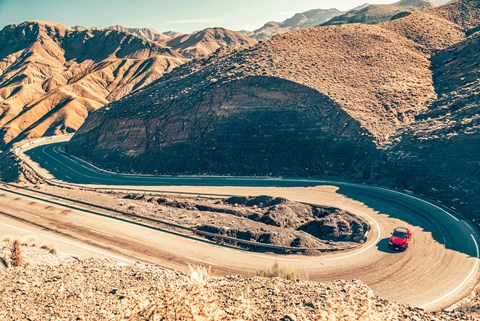
It is here, as in 1995, that our pilgrimage to the Sahara goes up (or, more accurately, down) a gear (or four). For this is a place and a road that could have been created for the express purpose of hedonism in cars of bewildering potency. In the original story Richard Bremner talks of battering the 512M’s silver-balled gearlever, of its flat-12 blaring, of windows dropped to better hear the engine’s spectacular cry, of feet skipping on pedals, and of arms twirling the unassisted steering this way and that. Close your eyes and even now, all these years later, you can see it, hear it, almost smell it; you can, with a little effort, recall an experience you never lived but which somehow feels more real than many you have.
Now, as then, there are no signs of the winter snows that can see the N9 gated shut, particularly between January and March. Today is a perfect winter’s day, the air crisp but mild in the Californian style. So perfect, in fact, I’m in no hurry to see it pass. The Purosangue, on the other hand, appears hell-bent on rocketing its way across this stretch of road as quickly as it can.
To be in its hot seat on a road like this is a curious fusion of the calm and the cacophonous, the composed and the chaotic, that 6.5-litre V12 the ever-goading anarchist. The car’s remarkable active suspension is little short of revelatory, fortifying this high and heavy (a shade over two tonnes) 4×4 with a formidable arsenal of traditionally contradictory attributes: rock-solid composure with compliance; keen turn-in without a shred of flightiness (certainly once the tyres are warm); ready-for-anything wheel travel with a confidence-swelling sense of control. But so colossal is the V12’s appetite for speed, and so hopelessly weak is this soul in the face of its temptation, that still the Purosangue refuses to deliver anything other than a world-filling, life-affirming, memory-searing symphony of a drive.
Leaving another hillside village of stacked homes and sleepy, slow-moving humanity, I crank the manettino to Sport/Hard (where Ferrari’s old bumpy-road mode was a one-size-fits-all affair, you now get damper settings within each mode), set the gearbox to manual and pack our remaining snacks tightly into the door bins and glovebox. They’ll soon be flung all over the cabin like a lightly salted plane crash nonetheless.
With your foot to the floor, first, second and third gears simply vanish, eviscerated by 715bhp, 528lb ft and the zero-loss traction of four fat Michelins working on warm dry tarmac.
It’s tempting to think, given that a 512M looks like a child’s drawing of a supercar and the Purosangue a crossover, that the flat-12 two-seater might have been the faster car over these roads. Based on the raw numbers at least, that’s unlikely. In 1995 joyriding Moroccan passengers climbed out of the 512M unable to stand or to speak, dumbfounded by the Ferrari’s warped physics. Nearly 30 years later the Purosangue uproots goalposts and challenges the impossible with the same startling alacrity.
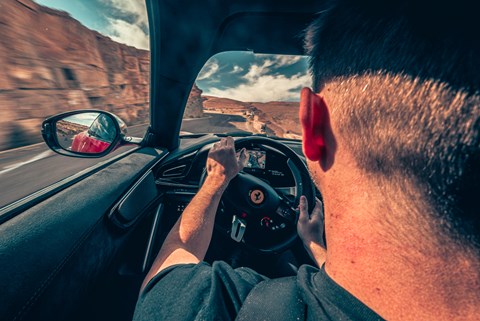
The M was good for 440bhp, revved to 6750rpm, went 0-62mph in 4.7 seconds and ran the quarter-mile in around 12.7 seconds. The 715bhp Purosangue revs to 8250rpm and goes 0-62mph a full 1.5 seconds quicker. A second quicker over the quarter-mile, too, it is decadently fast, not least because its composure soon has you spanking the V12 as you might the 1.0-litre four in a holiday rental, with predictably outrageous effects on your average speed.
The steering, so taut and quick-racked it doesn’t forgive a moment’s inattention on the motorway, feels perfectly judged now, effortlessly switching direction as we work our way higher and higher, rapidly gaining altitude via endless sequences of interwoven switchbacks. The brakes annihilate unwanted speed, and the corner speed you can carry – thanks to the tyres’ gummy grip and body’s pig-headed refusal to keel over more than a couple of degrees – takes some getting used to. Arrival times on Google Maps (no in-built navigation, remember) tumble like an altimeter in free-fall.
Missed the first part of our Purosangue adventure? Read it here
A new level of performance for SUV-kind? It certainly feels that way, though Aston Martin is entitled to argue. More than once it’s only the sense of the car rotating beneath me, rather than around me, that reminds me we’re not slung low in a conventional supercar. Indeed, paired with its relatively high hip point, the Ferrari’s combination of physics-defying suspension, rampant acceleration, brick-wall braking and high-g agility (the latter abetted by a version of the 812 Competition’s independent rear-wheel steering) is almost a bit much on particularly intense stretches of road, my squidgy organic form the weak link in the eye of this mercilessly physical storm. It never feels artificial, mind – remarkable given so much of its behaviour is defined by lines of code rather than the somehow more organic movements of springs and anti-roll bars.
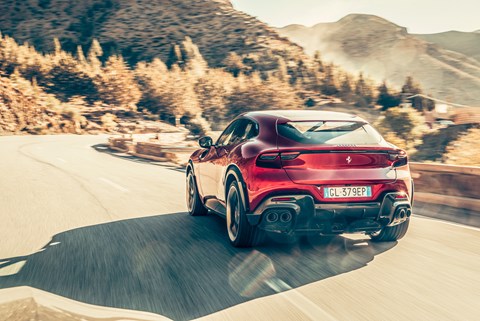
The Purosangue is also neutral, almost to a fault, feeling less overtly rear-driven in most instances than, say, Porsche’s Macan GTS. Excessive entry speeds are met with safe understeer, and you must dial back the ESC should you want the V12’s help to finish those corner exits with a flourish. The result is a fearsomely capable all-weather, all-roads machine. But were the Ferrari fitted with a torque-bias control, Toyota GR Yaris style, I’d be twisting it rearward.
The journey east, after a fuel stop in Ouarzazate, is a bewildering display of Morocco’s raw beauty. With the mountains behind us the pace of change slows, the road running plumb-line straight across what feels like the raw face of the Earth, so vast are the views. Nothing moves but the birds and the goats. There is some fuel, thankfully, but the stations are cash-only, their unadorned forecourts scattered with the weathered crankcases of long-dead engines like cast-iron carrion.
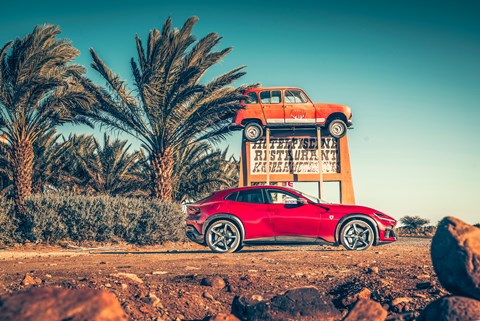
The Purosangue settles back into a fast, low-effort cruise. Gnarled milestones flash past. Time and distance, usually so rigid in their relationship, melt like warm wax. This, ultimately, is where your money goes. Making land travel this fast and this easy is expensive, and the Purosangue is not cheap: £313,360 before options, and likely north of £400,000 if you spec it like a typical buyer. The 512M cost £138,000 in 1995, or £270,000 adjusted for inflation, putting it on a par with the V6 hybrid 296 GTB in Maranello’s current line-up.
It’s not hard to see where that money goes. This is one dense ball of exotic engineering. The aluminium-intensive body (complete with 450-litre boot) may not use swathes of composites but the suicide rear doors are powered and wilfully weird if effective by design. The vast wheels – 22 inches at the front, 23 at the rear (the 512M’s tiny 18-inch turbines were surely cooler) – are slowed by carbon-ceramic brakes and a fiendishly complex by-wire system originally developed for the 296 GTB. It allows for the fluctuating levels of negative torque hybrids must tolerate as they dip in and out of regen. And though this Purosangue isn’t hybrid the system’s here nonetheless, giving more flexibility over the brake bias than would be possible with conventional brakes. It’s a superb system, with a firm and accurate pedal, and bodes well for Ferrari’s electric supercar in 2025.
As does, potentially, the suspension. As far back as 2018, no sooner had it confirmed the car was coming, Ferrari began talking about the Purosangue’s game-changing active bouncy bits. The system comprises four special dampers with token coil springs and no anti-roll bars. Each Multimatic unit features a damper rod but threaded rather than smooth, their teeth meshed with gears mounted to powerful three-phase electric motors built into the damper units.
Now, force your brain to consider that the actual springs do almost nothing. They’re present only to keep the car from sagging to the floor like an old Citroën when you turn it off. Instead everything – including the effective spring rate at any given moment, the dynamic ride height and the way in which the car moves as you drive – is the product of the ECU and the actions of those four electric motors. The car has complete, virtually instantaneous control over its behaviour, opening up a sandbox (appropriate…) of dynamic opportunity. To think the 512M had no electronic suspension adjustment whatsoever, though it did have pairs of damper units on each rear corner. Which is cool.
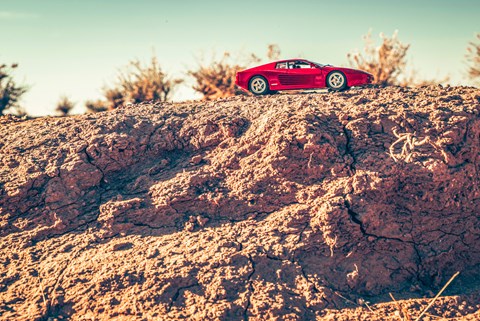
And then there’s the engine. Read contemporary tests of the 512M and they follow the same pattern: moan, moan, dated; moan, moan, awkward; moan, moan… but oh my God the engine! Back then it was the only car on sale with a flat-12 engine, Ferrari having used the format in F1 for years, until ground effect turned up and demanded a narrower, more packaging-friendly layout. The M’s engine was special. So too is the Purosangue’s. Some have questioned the wisdom of a rev-hungry, naturally-aspirated unit in this application. Torque-rich turbocharged engines and electric motors are certainly better at masking weight and responding to lazy, low-rev demands for instant acceleration. But such level-headed and objectively credible arguments don’t last long in the presence of this engine’s colossal charisma. It wants only for the 512M’s open-gate manual, even if that notion is as insane as it is exquisite.
Covering great swathes of the African continent, the Sahara comprises some 3.5 million square miles of eerie, beautiful emptiness. While much of it is rocky rather than sandy, its towering dunes are the manifestation of its vast and unknowable otherness; its hot, dry and otherworldly enormity.
Running hard against the dying light, we begin to lose the sun in swirling storms of dust. Shredded plastic flutters like Tibetan prayer flags on barbed wire fences and, where sand streams across the road like a dry flash flood, the lumpen grey tarmac is lost to the desert. The Purosangue is relentless: stoic in these body-rocking crosswinds, impervious to the suspension-testing subsidence and, with its filter-protected V12, tireless over these vast distances.
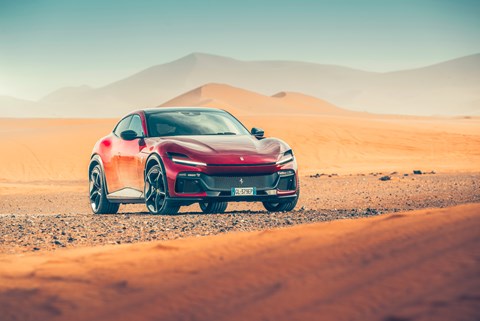
The dunes at Erg Chebbi appear like an optical illusion, miles away still yet already monolithic, their draw inexorable. As we get closer they look no more real, their weird beauty hard to trust in this age of AI-altered imagery.
But they are real. And here you can drive right into them. I slow, lift the body on its suspension, toggle Comfort/Soft and drop from the tarmac onto the hard-packed grit and rock that stretches to the dunes. They could drive these stretches in the 512M, too, but deep sand was impassable, as guaranteed to beach the rear-drive, low-slung supercar as wet cement. In truth the Purosangue is little different, and deliberately so. Yes, it holds its body higher off the ground, and yes it sends its power to all four wheels. But it was never conceived as an off-roader, let alone a dune basher. Just skirting between the steep sand slopes, finding a way through this alien landscape of golden, granular hills and lonely, skeletal trees, you feel the soft sand’s cloying grasp, the Michelins spinning on its ethereal, traction-less liquidity and the Ferrari sliding suddenly sideways on a whisper of V12 effort.
It’s way more than we asked for. This landmark Ferrari has excelled time and again, over more than 900 brutal miles (1800 by the time it’s safely home). Biting cold, fierce heat, fast motorway days, the melee of Marrakesh, 8200rpm gearchanges, mountain passes, rough-hewn roadworks, eye-watering sandstorms – the Purosangue has monstered them all; reliable, omni-talented, unfailingly special. Was this journey tougher and more dramatic in 1995, in the mid-engined 512M? Of course. Does that in any way diminish the emotional heft of this drive in this car? It does not.
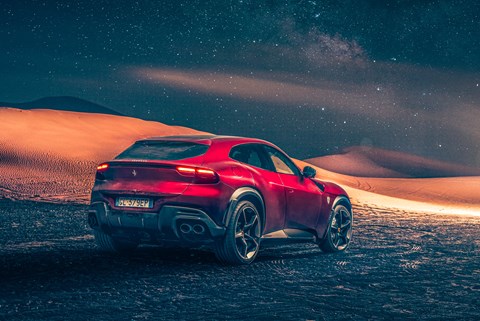
Hours later, after dark, the dunes are transformed. The winds are gone, the screaming storm with them, and in their wake all is peaceful. Climbing a ridge the scene is rich with the incongruity at the heart of Richard Bremner’s original idea. Below, just visible in the inky blackness, sits the still and silent Purosangue, its tyres grey with dust. Where I stoop to grab a handful the sand flows through my fingers like silken, bone-dry water. Somewhere out in the darkness an archaic pick-up truck shudders, bangs and coughs its last, rolling to a halt on the distant road. The silence floods in once again, and with it a weird sense, out here at least, of the arbitrary nature of time. And I think of the 512M, here in this same spot all those years ago.
Two Ferraris, 30 years apart. But so insignificant is the time between them that, so far as this landscape is concerned, ancient, unchanged and sentinel, they might be the same car moments apart, echoes of one another in eternity.